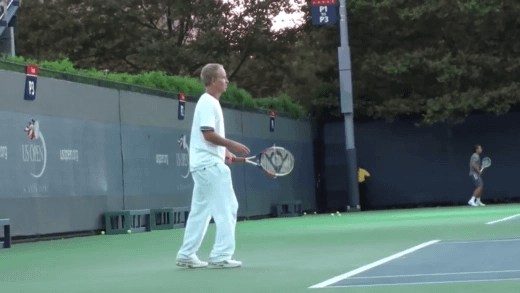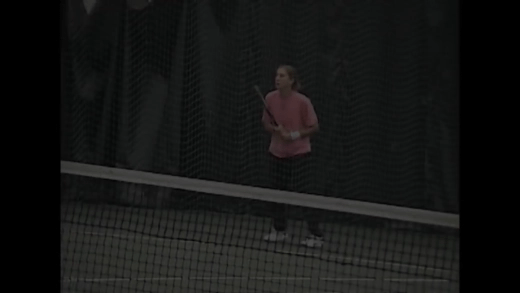“First move well, then move often.” - Gray Cook
Gray Cook is an internationally recognized physical therapist, specializing in movement patterning and correction. Though in this context, he speaks regarding fundamental movement skills, the statement applies equally well to technical development in junior players. Cook goes on to specify that well ≠ perfect; similarly, we are not demanding perfection during Stages 1 & 2, only technique that is effective, and that will not lower the student's long-term ceiling.
Well, not perfect.
For example, a new player starts their swing from the racket drop position (low takeback level with the ball). This allows them to time the ball more easily, and therefore build their rally/point play skills. Eventually, we would like for them to incorporate a higher takeback and loop, in order make the transition between loading and acceleration more efficient; however, there is nothing inherently "wrong" with an abbreviated swing (see McEnroe). Once the player is more capable of receiving the ball, it will not be difficult to modify their takeback, as we will be adding a new element to the stroke, rather than completely changing the base motor pattern.
Conversely, a player serving with a forehand grip may be effective in getting the ball in the box; however, this technical error will prevent them from later developing a high-level serve.
Coaches must also be careful that their technical concessions do not negatively impact players' performance in competition (first, do no harm!). Recently, I have encountered a coach who teaches the forehand as a left-handed backhand, intending that the off-hand add stability. There is no inherent issue with using two hands on the forehand, it was done effectively by Seles, Santoro, Bartoli and others. The problem here is that when the ball comes to the backhand side, the player must swap the position of their hands on the grip. On anything but a predetermined feed, this greatly hinders their ability to differentiate and switch between their forehand and backhand, and therefore play the game in a realistic setting. Indeed, the professional players mentioned all kept their dominant hand on the bottom of the racket, and placed their non-dominant hand at the top of the handle when hitting a forehand.
Why is it important to move well before moving often?
In recent years, the USTA and other governing bodies in tennis have encouraged a "Games Based Approach" to teaching. In this methodology, technique is a byproduct of playing the game. Many have misinterpreted this to mean that no technical instruction should be given, and that students will "evolve" proper mechanics by adapting to the game's demands. The issue here is that playing and playing efficiently are two different things (especially in tennis)---these students are moving often, but not well. One only has to watch their local USTA 3.5 team to see the "mutations" that result from years of play without feedback/instruction. Moving often, poorly, is nothing more than saving bad motor patterns over and over again. Why not fix limiting technique early, and allow the player the chance to progress as far as they want?
Why not immediately shoot for perfect?
We are teaching kids to play tennis, not creating works of art---there must be a balance between the utilitarian and the ideal. This is especially true in group classes, where individual attention and correction is difficult to provide. Rather than spend inordinate amounts of time and effort "perfecting" every child's swing with shadow strokes and lines, coaches should look to equip their students with the basic tools to play and practice the game. Ask yourself: "How simple can I make this without it being limiting in the future?"
Many coaches overlook this principle; their students look fantastic receiving feeds in a line, but fall apart in open situations. Does a 7-year-old need Federer's service motion to play tennis? Would that child be better served with a simpler (but still correct!) swing that puts the ball in the box, allowing them to play the game, have fun, and practice in a competition-realistic setting? It's a fact that, for children, some things are just easier to learn later (e.g. teaching a 3-year-old to tie their shoes is likely to take a herculean effort). Similarly, demanding "perfect" technique at beginner levels creates too high a barrier to entry. Once a player has acquired basic rallying skills by moving well and often, and is invested in learning the game, we can easily grow their technique in a more organic way.
How can we ensure that players are moving well?
The first thing coaches can do is define what moving well means. For this purpose, I have established a technical range of acceptability for each stroke. This creates room for players to develop a personal style with respect to their biomechanics, while still delineating efficient and inefficient. For example, a player may use anywhere from an eastern to semi-western grip on the forehand. Using a continental or western grip may limit their effectiveness in the future; therefore, these grips are outside the range of acceptability and would be corrected.
Coaches must also be aware of potential issues with each stroke, and vigilant in correcting them as soon as possible. I find that the easiest method of doing this is to build feel-based corrective exercises into the progressions used to teach the stroke. Daily use of these exercises prevents students from "mutating" too far from the ROC. "An ounce of prevention is worth a pound of cure."
Summary
I find it helpful to pose the following questions when evaluating an entry-level program:
-Is the floor too high?
Players spend more time practicing a coach’s ideal movements than learning the game. They are experiencing tennis as a closed-skill, rather than the open-skill sport that it is. These players will be fragile in competition (if they are able to compete at all), and will in all likelihood leave the sport due to boredom or frustration.
-Is the ceiling too low?
Players are allowed to use any technique necessary to play. When these players attempt to progress to the next level, they will be hindered by inefficiencies, requiring them to unlearn ingrained motor patterns and relearn more effective ones to advance. This will take a massive amount of time and effort that could be better spent elsewhere.
I hope that this article was helpful in explaining my approach to beginner development.
Check out Gray Cook at https://www.functionalmovement.com/
If you have any questions, or disagree with anything written, please comment below!






